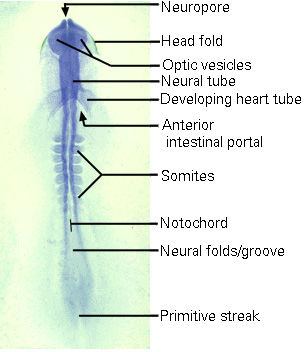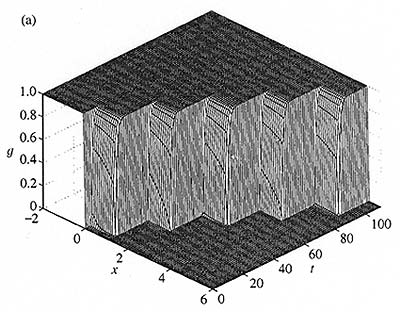 |
Mathematical models for aspects of somite development
The mechanisms that generate the spatiotemporal periodic patterning of somites (spherical aggregations of cells) along the length of the vertebrate embryonic body axis is still one of the major unresolved problems in developmental biology, despite the availability of a huge amount of experimental data.
We formulate mathematically (publication 123), a word model proposed by Primmett et al (Development, 105, 119-130, 1989). Using a mixture of analysis and numerical simulation, we show that the model can robustly produce a periodic pattern of repeating segments corresponding to somites. We extend the model (publication 162) to account for new experimental evidence that the growth factor FGF-8 controls the movement of the determination front (behind which cells form somites) as it progresses from head to tail. The model produces results that are consistent with the experimental results on the effects of adding FGF-8 to a growing embryo.
Although the formation of patterning behind a determination front is very common, chick somitogenesis exhibits a novel type of pattern formation in which a signal (for example, l- fng and c-hairy-1) sweeps along in the opposite direction to that of somite formation, narrowing simultaneously as a new somite forms. In publication 114, we present a model that exhibits such novel "travelling wave" behaviour and show that it is consistent with experimental observations.
All the above studies use mathematical modelling as an hypothesis-testing tool, as well as an hypotheses-generating tool. Furthermore, the models make experimentally testable predictions.
 |
In the development of the early chick embryo, somites form sequentially from head to tail. [Reproduced with permission]
 |
Numerical simulation of our model (publication 123) showing the spatiotemporal evolution of the proposed "somitic factor" g, which is proposed as a trigger for somite formation. As we move along from head to tail (x increasing) blocks of tissue are determined as somitic, leading to a sequentially generated periodic pattern. [Reproduced from publication 123 with permission].
** Work carried out in collaboration with S. Schnell, C. Stern, J.R. Collier, D. McInerney, R. Baker, D. Gavaghan and P. Houston